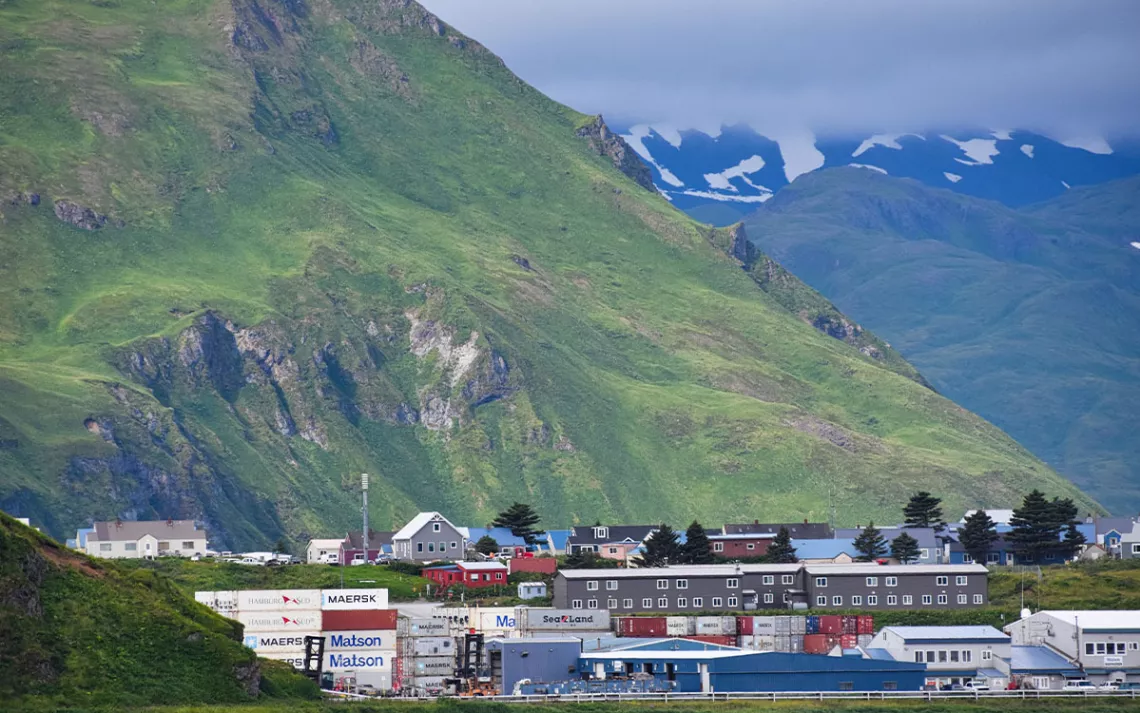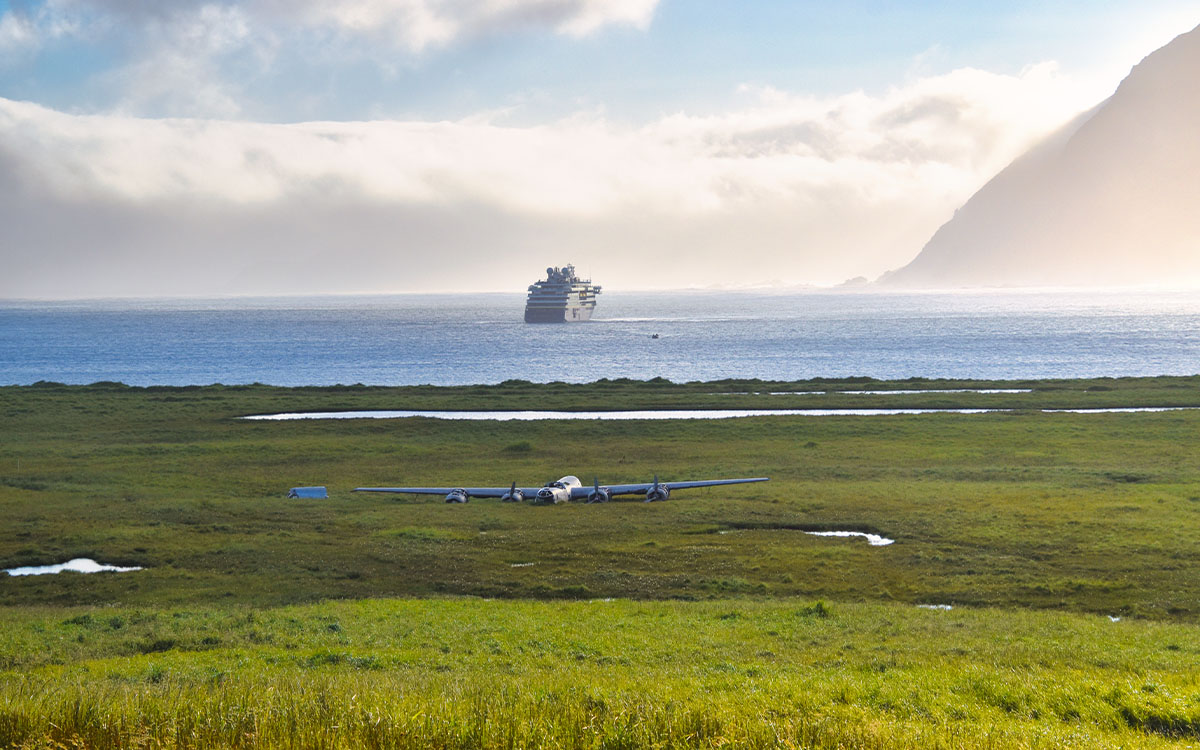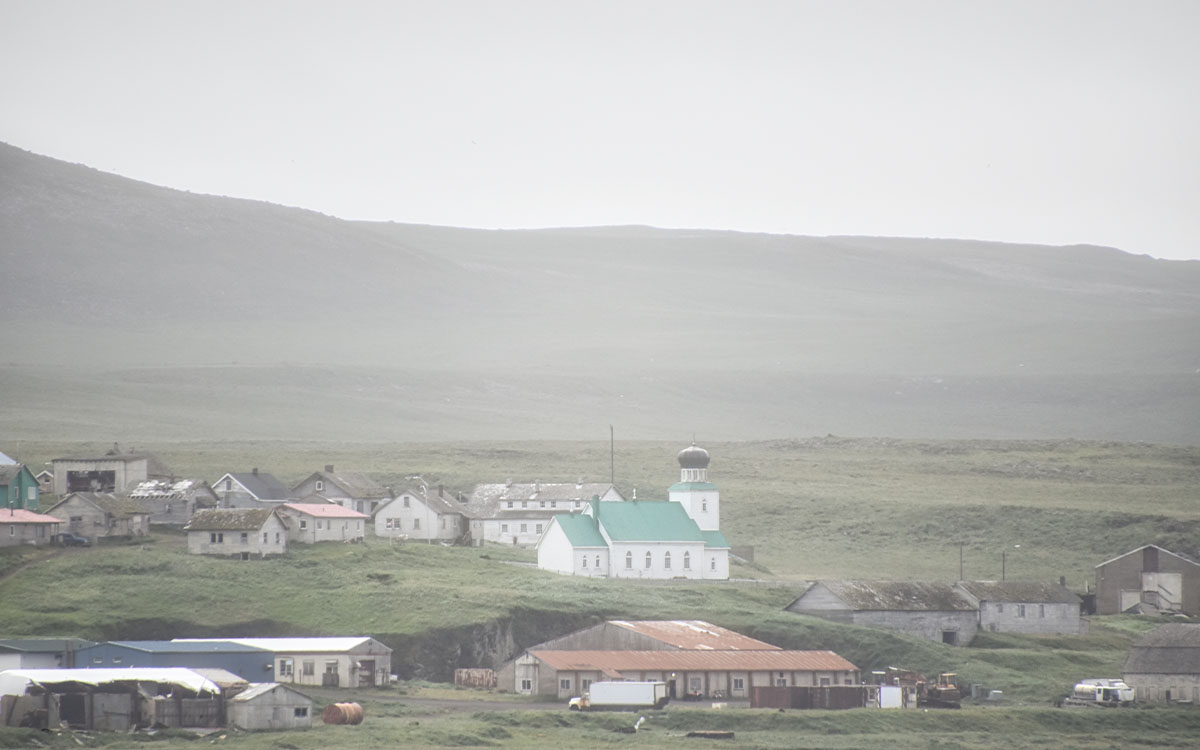The Cascading Effect of Climate Change in the Aleutians and Across the Bering Sea
The waters in the region are warming four times faster than the rest of the ocean

Dutch Harbor on Unalaska Island in the Aleutians.
Gail Ashton is a non-native species scientist and a diver for Lindblad Expeditions. She’s not new to Nome, St. Paul, Dutch Harbor, and the Aleutians in Alaska’s Bering Sea. Previously, she came to the island of St. Paul to share her research on invasive species and was stunned to discover a lesson about climate change.
“In every place I came to, especially in the Aleutians,” says Ashton, there was a mixed reception to her research. She heard the people around the islands say, “That’s great and all, but we have more imminent problems which are related to climate change.” Now that she's back, she's heard that climate change has only made things worse for the crab industry at St. Paul, where, she says, the crab fisheries have crashed. “The presence and importance of that industry is central to the town.”
According to the NOAA Fisheries 2023 Ecosystem Status Reports for the eastern Bering Sea, Aleutian Islands, and Gulf of Alaska, the waters in the region are warming four times faster than the rest of the ocean. The impact is being felt across the region. From phytoplankton to zooplankton to Pacific perch and Pacific cod or snow crabs, the ecosystem is very much out of alignment. In a subsistence economy, that can mean the loss of everything crucial for survival.
I was visiting the region aboard the National Geographic Resolution, hitching a ride with Lindblad to see first-hand St. Paul, Dutch Harbor, and the very remote Aleutian Islands. Some are so remote that scientists have trouble funding the journey to get there for research. Ashton was serving as a diver and specialist for Lindblad. We both had hoped to check in on St. Paul, but bad weather changed that plan.
St. Paul Island sits 300 miles from the mainland of Alaska in the Bering Sea. It’s small; you have to pinch in on Google Maps for it to show up. Part of the Pribilof Islands, it, along with the island of St. George, are home to the world’s largest Aleut (Unangan) community, an Indigenous people who originally settled the Aleutian chain of islands almost 10,000 years ago. Over the last 300 years, their community has suffered a series of colonial injustices: slavery at the hands of Russian and US governments; internment during World War II, which led to the American military destroying Aleutian homes after forcing them to move them overnight, and now, climate change.

B-24D Liberator on Atka Island in the Aleutians, with the Resolution in the background.

A fog shrouded St. Paul Island. Taken from the sea on board the NG Resolution.
Even so, they haven’t given up on their original connection to the sea. “We feel like it’s our responsibility to bring back the health of our ecosystem,” says John Melovidov, the recently elected tribal council president of the Aleut Community of St. Paul Island. Melovidov is working, he says, to “ensure that our people have a long-term plan for staying here in St. Paul.”
The St. Paul community hopes to have a positive impact through the proposed Alaĝum Kanuux̂* (“the heart of the ocean”) marine sanctuary as part of their PRIME Initiative (the Pribilof Island Marine Island Ecosystem). Tribal leaders are seeking a comanaged sanctuary that takes into consideration their concerns and that will help protect marine life. The nomination was successfully accepted by NOAA’s Office of National Marine Sanctuaries, but he says that it is currently at a standstill due to resistance in the fishing industry.
According to Ivonne Ortiz, senior research scientist at the University of Washington’s Cooperative Institute for Climate, Ocean, and Ecosystem Studies and an affiliate for NOAA’s Alaska Fisheries Science Center, annual warming, recurring heat waves, sea ice loss, and sometimes very subtle shifts in climate have pushed some species that were once dominant here to the edge. Pacific cod, for example, are an important species for the food chain, and the second-largest commercial groundfish in Alaska. Warmer waters, as compared to the mean, have negatively affected their growth and survival rates. In the Aleutians, they are especially affected by temperature changes.
Ortiz says cod are very temperature sensitive. “To feel comfortable,” she says, the fish “have favorite temperature ranges.” If it is too cold or hot, they’ll be lethargic. As temperatures warm, they are “happier” and can move and look for prey, but that means they need a good, healthy, and fatty food supply. The production of those food sources, like phytoplankton and zooplankton, are shifting due to temperature changes. In the end, a mismatch occurs between cod energy needs (higher temperatures require more energy) and their prey availability. This impacts sharks, birds, and mammals that rely on quality cod for food.
On board the Resolution, I catch up with Nicola Ransome, a whale biologist with Murdoch University who runs La Orca de Sayulita, a whale-watching and research organization. She too was tagging along on the ship, hoping for the rare chance to study humpback whales in the Aleutians, which also seem to be affected by climate change. “I have a theory that Aleutian whales are smaller,” she tells me. She saw a whale in 2018 that was small and labeled it a juvenile. When she looked up the same whale on the whale tracking app, Happy Whale, she discovered it was first seen in 2005. That led her to realize that sometimes a whale gets labeled a juvenile, but it might actually just be an older, smaller whale.
“I don’t think there’s food for them,” she said.
Similarly, snow crabs are one of the biggest victims of climate shifts, like climate change and heat waves. Like for cod, higher temperatures mean that snow crabs need more caloric energy. When it’s not available, they starve. When temperatures change, it also means cod become a problem for snow crabs. “The cold waters act as a barrier for cod,” says Connie Melovidov, John’s cousin and a scientist who supports the Aleut Community of St. Paul Island by tracking federal fisheries management issues. Her master’s research is on snow crabs. “And so when you have that thermal barrier, it acts like a natural environmental barrier—so that they're not preying on juvenile snow crabs and other small species.”
The devastation of the snow crab industry has had a rippling effect across St Paul, which has the largest snow crab processing plant in the United States. “Because there is no crab industry,” says John Melovidov, the city is “losing out on average $2.7 million a year of their operating budget.” That, he says, means cutbacks. “We no longer have a police force.” Without crab boats coming to the island, local businesses also suffer.
The Aleutian Islands have remnants of war scattered throughout: a crashed B-24D Liberator on Atka; rusted fueling tanks on Great Sitkin Island; a collection of trash that litters beaches. For 10,000 years, the Aleuts lived with nature; it took only 300 years of modern human impact to undo it all.
“I know that other tribal communities probably feel the same way,” Connie says, “but our voices are very unique, and our perspectives. As tribal and Indigenous people, our values are what carry us and guide us through. . . . We can't physically control the ecosystem, but we do what we can to make sure we’re not harming it.”
 The Magazine of The Sierra Club
The Magazine of The Sierra Club



